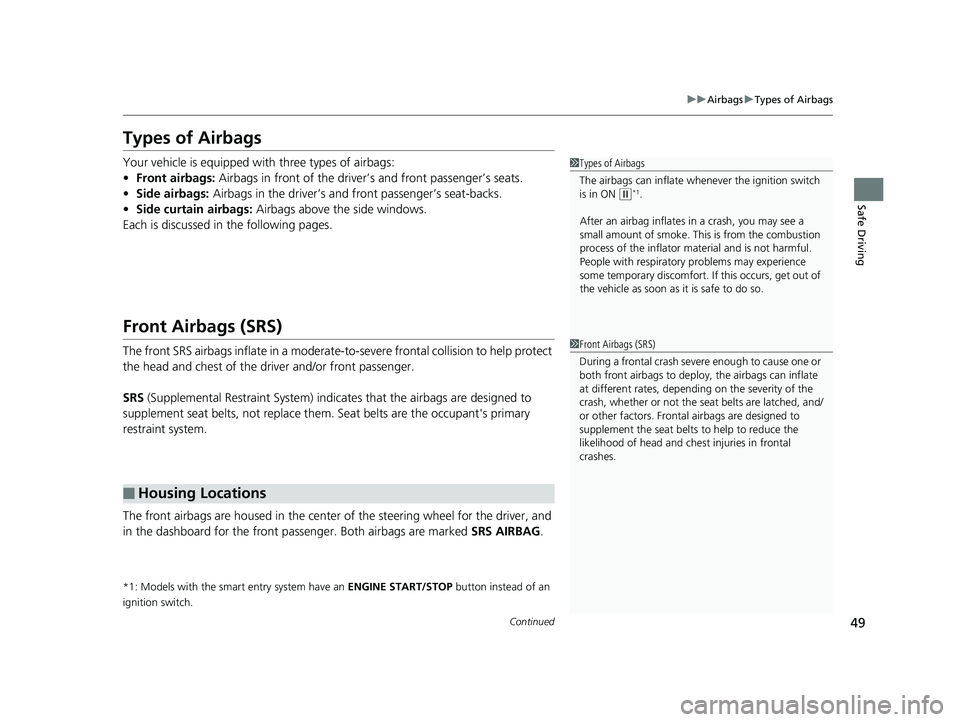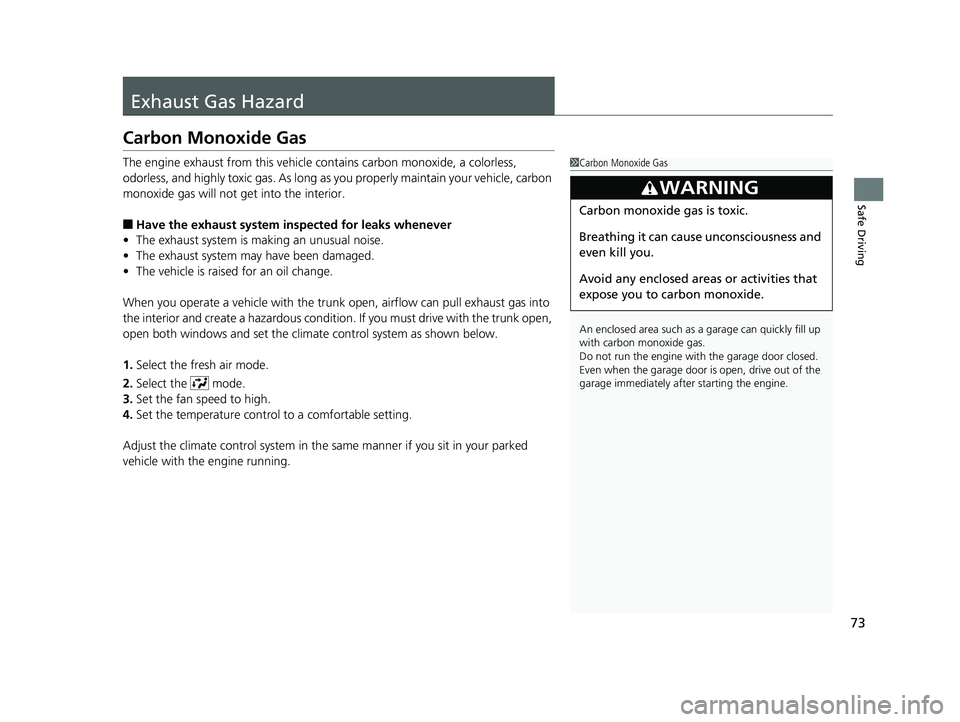Page 28 of 675
26
Quick Reference Guide
Maintenance (P 545)
Under the Hood (P 555)
● Check engine oil, engine coolant, and windshield washer fluid. Add
when necessary.
● Check brake/clutch
* fluid.
● Check the battery condition monthly.
aPull the hood release handle under the corner of the dashboard.
bLocate the hood latch lever, pull it up, and then raise the hood.
Once you have raised the hood slightly, you can release the lever.
cWhen finished, close the hood and make sure it is firmly locked in
place.
Lights (P 570)
● Inspect all lights regularly.
Wiper Blades (P 579)
● Replace blades if they leave
streaks across the windshield.
Tires (P 582)
● Inspect tires and wheels
regularly.
● Check tire pressures regularly.
● Install snow tires for winter
driving.
19 CIVIC 2D HCM (KA KL KC)-31TBG6300.book 26 ページ 2018年9月4日 火曜 日 午後1時38分
Page 29 of 675
Quick Reference Guide
27
Handling the Unexpected (P 605)
Flat Tire (P 607, 614)
● Park in a safe location and replace the
flat tire with the compact spare tire
* in
the trunk, or repair the flat tire using the
tire repair kit
*.
Indicators Come On
(P 635)
● Identify the indica tor and consult the
owner's manual.
Engine Won’t Start
(P 626)
● If the battery is dead, jump start using a
booster battery.
Blown Fuse (P 641)
● Check for a blown fuse if an electrical
device does not operate.
Overheating (P 633)
● Park in a safe location. If you do not see
steam under the hood, open the hood,
and let the engine cool down.
Emergency Towing
(P 645)
●Call a professional towing service if you
need to tow your vehicle.
* Not available on all models
19 CIVIC 2D HCM (KA KL KC)-31TBG6300.book 27 ページ 2018年9月4日 火曜 日 午後1時38分
Page 30 of 675
28
Quick Reference Guide
What to Do If
*1:Except U.S. models with continuously variable transmission
The ignition switch does
not turn from
(0 to (q.
Why?
The power mode does not
change from VEHICLE OFF
(LOCK) to ACCESSORY.
Why?
The steering wheel may be locked.
●Try to turn the steering wheel left and right
while turning the ignition key.
●Move the steering wheel left and right after pressing the
ENGINE START/STOP button.
The ignition switch does
not turn from
(q to (0 and
I cannot remove the key.
Why?
The power mode does not
change from ACCESSORY
to VEHICLE OFF (LOCK).
Why?
The shift lever should be moved to (P.
Models without smart entry system
Models with smart entry system
Models without smart entry system
Models with smart entry system*1
Models without smart entry system
Models with smart entry system
19 CIVIC 2D HCM (KA KL KC)-31TBG6300.book 28 ページ 2018年9月4日 火曜 日 午後1時38分
Page 33 of 675
31
Quick Reference GuideUnleaded gasoline with a
Pump Octane Number
(PON) of 91 or higher is
recommended.
Is it possible to use
unleaded gasoline with a
Pump Octane Number
(PON) of 87 or lower on
this vehicle?
Unleaded gasoline with a pump octane number of 91 or higher
is recommended.
Use of lower octane gasoline can cause occasional metallic
knocking noise in the engine and will result in decreased engine
performance.
Use of gasoline with a pump octane less than 87 can lead to
engine damage.Models with SPORT mode
19 CIVIC 2D HCM (KA KL KC)-31TBG6300.book 31 ページ 2018年9月4日 火曜日 午後1時38分
Page 42 of 675

uuSeat Belts uAbout Your Seat Belts
40
Safe DrivingThe seat belt system in cludes an indicator on
the instrument panel to remind the driver or a
front passenger or both to fasten their seat
belts.
If the ignition switch is turned to ON
(w*1 and
a seat belt is not fast ened, a beeper will sound
and the indicator will blink. After a few
seconds, the beeper will stop and the
indicator will come on and remain illuminated
until the seat belt is fastened.
The beeper will periodically sound and the
indicator will blink while the vehicle is moving
until the seat belt is fastened.
*1: Models with the smart entry system have an ENGINE START/STOP button instead of an
ignition switch.
■Seat Belt Reminder1 Seat Belt Reminder
The indicator will also co me on if a front passenger
does not fasten their seat belt within six seconds after
the ignition switch is turned to ON
( w*1.
When no one is sitting in th e front passenger’s seat,
the indicator will not come on and the beeper will not
sound. The indicator also may not come on and the
beeper may not sound when the occupant is not
heavy enough to trigger th e weight sensor. Such
occupants (e.g., infants and smaller children) should
be moved to the rear seat as a deploying front airbag
likely will injure or kill them. 2 Protecting Child Passengers P. 60
19 CIVIC 2D HCM (KA KL KC)-31TBG6300.book 40 ページ 2018年9月4日 火曜 日 午後1時38分
Page 51 of 675

49
uuAirbags uTypes of Airbags
Continued
Safe Driving
Types of Airbags
Your vehicle is equipped wi th three types of airbags:
• Front airbags: Airbags in front of the driver’s and front passenger’s seats.
• Side airbags: Airbags in the driver’s and front passenger’s seat-backs.
• Side curtain airbags: Airbags above the side windows.
Each is discussed in the following pages.
Front Airbags (SRS)
The front SRS airbags inflate in a moderate-to-severe frontal collision to help protect
the head and chest of the driver and/or front passenger.
SRS (Supplemental Restraint System) indica tes that the airbags are designed to
supplement seat belts, not replace them . Seat belts are the occupant's primary
restraint system.
The front airbags are housed in the center of the steering wheel for the driver, and
in the dashboard for the front pass enger. Both airbags are marked SRS AIRBAG.
*1: Models with the smart entry system have an ENGINE START/STOP button instead of an
ignition switch.
■Housing Locations
1 Types of Airbags
The airbags can inflate whenever the ignition switch
is in ON
(w*1.
After an airbag inflates in a crash, you may see a
small amount of smoke. This is from the combustion
process of the infl ator material and is not harmful.
People with respiratory pr oblems may experience
some temporary discomfort. If this occurs, get out of
the vehicle as soon as it is safe to do so.
1 Front Airbags (SRS)
During a frontal crash severe enough to cause one or
both front airbags to deploy, the airbags can inflate
at different rates, dependi ng on the severity of the
crash, whether or not the se at belts are latched, and/
or other factors. Frontal airbags are designed to
supplement the seat belts to help to reduce the
likelihood of head and chest injuries in frontal
crashes.
19 CIVIC 2D HCM (KA KL KC)-31TBG6300.book 49 ページ 2018年9月4日 火曜 日 午後1時38分
Page 59 of 675

57
uuAirbags uAirbag System Indicators
Continued
Safe Driving
Airbag System Indicators
If a problem occurs in the airbag system , the SRS indicator will come on and a
message appears on the driver information interface.
■When the ignition switch is turned to
ON
(w*1
The indicator comes on for a few seconds,
then goes off. This te lls you the system is
working properly.
If the indicator comes on at any other time, or does not come on at all, have the
system checked by a dealer as soon as po ssible. If you don’t, your airbags and seat
belt tensioners may not work properly when they are needed.
*1: Models with the smart entry system have an ENGINE START/STOP button instead of an
ignition switch.
■Supplemental Restraint System (SRS) Indicator
1 Supplemental Restraint Sy stem (SRS) Indicator
3WARNING
Ignoring the SRS indicator can result in
serious injury or death if the airbag systems
or tensioners do not work properly.
Have your vehicle checked by a dealer as
soon as possible if th e SRS indicator alerts
you to a possible problem.
19 CIVIC 2D HCM (KA KL KC)-31TBG6300.book 57 ページ 2018年9月4日 火曜 日 午後1時38分
Page 75 of 675

73
Safe Driving
Exhaust Gas Hazard
Carbon Monoxide Gas
The engine exhaust from this vehicle contains carbon monoxide, a colorless,
odorless, and highly toxic gas. As long as you properly maintain your vehicle, carbon
monoxide gas will not get into the interior.
■Have the exhaust system in spected for leaks whenever
• The exhaust system is ma king an unusual noise.
• The exhaust system may have been damaged.
• The vehicle is raised for an oil change.
When you operate a vehicle with the trunk open, airflow can pull exhaust gas into
the interior and create a hazardous condition. If you must drive with the trunk open,
open both windows and set the climat e control system as shown below.
1. Select the fresh air mode.
2. Select the mode.
3. Set the fan speed to high.
4. Set the temperature control to a comfortable setting.
Adjust the climate control system in the same manner if you sit in your parked
vehicle with the engine running.
1 Carbon Monoxide Gas
An enclosed area such as a garage can quickly fill up
with carbon monoxide gas.
Do not run the engine with the garage door closed.
Even when the garage door is open, drive out of the
garage immediately afte r starting the engine.
3WARNING
Carbon monoxide gas is toxic.
Breathing it can cause unconsciousness and
even kill you.
Avoid any enclosed areas or activities that
expose you to carbon monoxide.
19 CIVIC 2D HCM (KA KL KC)-31TBG6300.book 73 ページ 2018年9月4日 火曜 日 午後1時38分